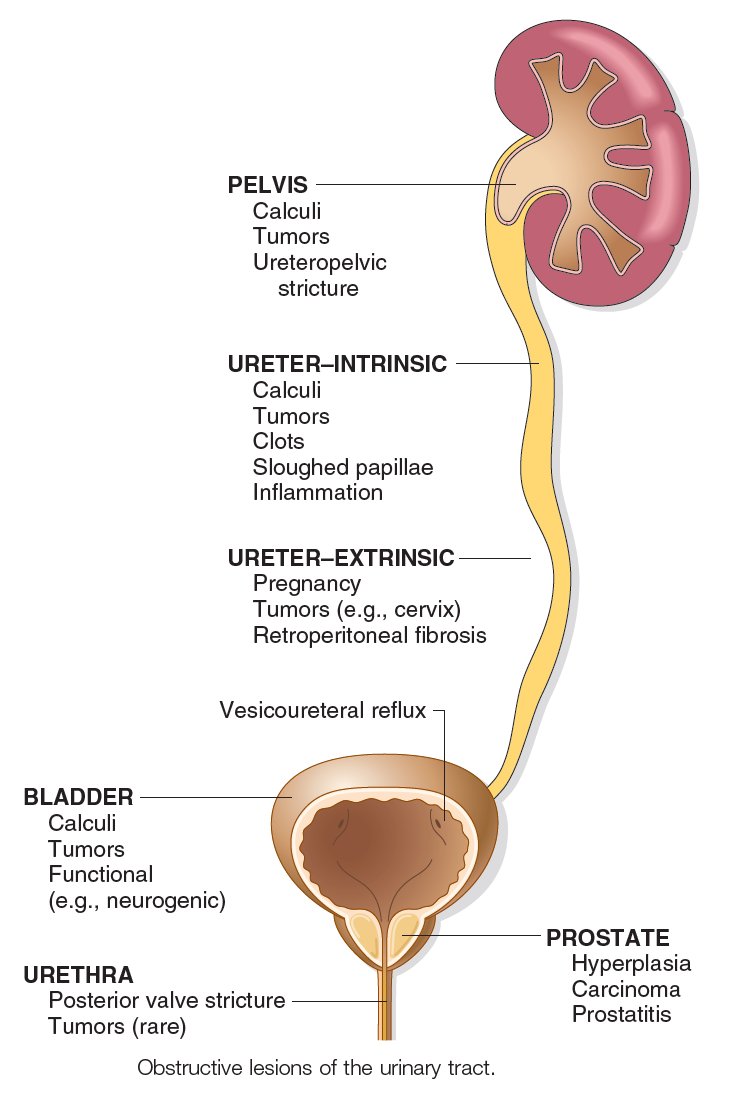Makindo Medical Notes"One small step for man, one large step for Makindo" |
|
|---|---|
| Download all this content in the Apps now Android App and Apple iPhone/Pad App | |
| MEDICAL DISCLAIMER: The contents are under continuing development and improvements and despite all efforts may contain errors of omission or fact. This is not to be used for the assessment, diagnosis, or management of patients. It should not be regarded as medical advice by healthcare workers or laypeople. It is for educational purposes only. Please adhere to your local protocols. Use the BNF for drug information. If you are unwell please seek urgent healthcare advice. If you do not accept this then please do not use the website. Makindo Ltd. |
Urinary Tract Obstruction
-
| About | Anaesthetics and Critical Care | Anatomy | Biochemistry | Cardiology | Clinical Cases | CompSci | Crib | Dermatology | Differentials | Drugs | ENT | Electrocardiogram | Embryology | Emergency Medicine | Endocrinology | Ethics | Foundation Doctors | Gastroenterology | General Information | General Practice | Genetics | Geriatric Medicine | Guidelines | Haematology | Hepatology | Immunology | Infectious Diseases | Infographic | Investigations | Lists | Microbiology | Miscellaneous | Nephrology | Neuroanatomy | Neurology | Nutrition | OSCE | Obstetrics Gynaecology | Oncology | Ophthalmology | Oral Medicine and Dentistry | Paediatrics | Palliative | Pathology | Pharmacology | Physiology | Procedures | Psychiatry | Radiology | Respiratory | Resuscitation | Rheumatology | Statistics and Research | Stroke | Surgery | Toxicology | Trauma and Orthopaedics | Twitter | Urology
🚨 Obstructive Uropathy = any blockage of urine flow between the renal collecting ducts and the urethral meatus. 👉 Unilateral ureteric obstruction usually causes no detectable change in urine flow or creatinine. 👉 Renal failure develops only when both kidneys are obstructed or in patients with a single functioning kidney.
ℹ️ About
- Obstruction can occur anywhere from collecting ducts → urethral meatus.
- 🖼️ Imaging usually shows dilatation proximal to obstruction (hydronephrosis, hydroureter).
- ⚠️ Chronic obstruction may cause irreversible renal damage.
🧬 Causes
- Renal: Papillary necrosis, staghorn calculus, tumour, clot.
- Ureteric: Stone, extrinsic tumour (e.g. cervical, colorectal), intrinsic tumour, retroperitoneal fibrosis.
- Bladder: Calculi, tumour, clot, neuropathic bladder, retention (e.g. constipation).
- Urethral: Prostatic hypertrophy, prostate cancer, urethral stricture, stone, phimosis.

🩺 Clinical Presentation
- 🔺 AKI: ↑ creatinine, metabolic acidosis, hyperkalaemia.
- Above bladder: Flank pain, fullness.
- Partial bladder outlet obstruction: Hesitancy, weak stream, polyuria, nocturia.
- At/below bladder: Acute retention, painful distended bladder.
- Exam: Palpable bladder, DRE may show enlarged prostate or hard stool.
🔎 Investigations
- 🧪 Bloods: FBC, U&E → AKI, metabolic acidosis, hyperkalaemia.
- 🖥️ Ultrasound: First-line, shows hydronephrosis/hydroureter, identifies obstruction level.
- CT urogram / spiral CT if unclear cause.
- Radionuclide scan (MAG3/DTPA) if function assessment required.
- Bladder scan → postvoid residual >200 mL = abnormal, suggests outlet obstruction.
💡 Post-Obstructive Diuresis: After relief of obstruction, patients may pass very high volumes of urine due to retained sodium/urea and impaired concentrating ability. 👉 Requires close monitoring and IV fluid replacement to prevent hypovolaemia and electrolyte disturbance.
🛠️ Management
- 🚑 Immediate: Catheterisation in retention, monitor urine output.
- 📡 Identify level: Ultrasound ± further imaging to determine site & cause.
- ⚠️ Monitor: Watch for post-obstructive diuresis, correct with fluids and electrolytes.
- 👨⚕️ Male BOO: α1-blocker (tamsulosin) or 5α-reductase inhibitor (finasteride). TURP if severe/progressive.
- 🩺 Definitive: Stent insertion, nephrostomy, or surgery depending on cause (e.g. stone removal, tumour resection, fibrosis release).
💡 Exam Pearls:
• Always check for reversible causes (stones, prostate).
• Unilateral obstruction = no creatinine rise; bilateral obstruction = AKI.
• Post-obstructive diuresis is a common viva question – fluids must match output.